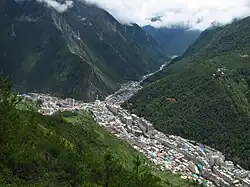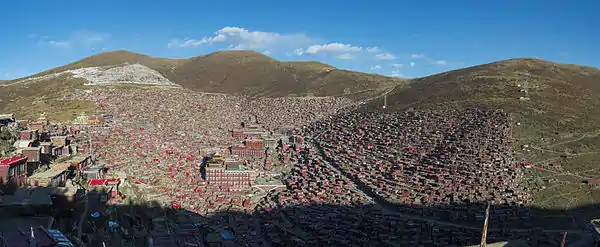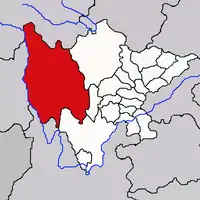Kangding
康定市 · དར་མདོ་གྲོང་ཁྱེར། Dardo, Tachienlu, Dartsedo | |
|---|---|
 Kangding from above | |
.png.webp) Location of Kangding City (red) within Garzê Tibetan Autonomous Prefecture (yellow) and Sichuan | |
 Kangding Location of the city center in Sichuan  Kangding Kangding (China) | |
| Coordinates (Kangding government): 29°59′55″N 101°57′25″E / 29.9985°N 101.9569°E | |
| Country | China |
| Province | Sichuan |
| Autonomous prefecture | Garzê |
| Municipal seat | Lucheng Subdistrict |
| Area | |
| • Total | 11,486 km2 (4,435 sq mi) |
| Elevation | 2,560 m (8,400 ft) |
| Population (2020)[1] | |
| • Total | 126,785 |
| • Density | 11/km2 (29/sq mi) |
| • Major ethnic groups | Han Tibetan |
| Time zone | UTC+8 (China Standard) |
| Postal code | 610000 |
| Website | www |
| Kangding | |||||||||
|---|---|---|---|---|---|---|---|---|---|
| Chinese name | |||||||||
| Chinese | 康定 | ||||||||
| Hanyu Pinyin | Kāngdìng | ||||||||
| Postal | Kangting | ||||||||
| |||||||||
| Dartsedo (Darzêdo) | |||||||||
| Simplified Chinese | 打箭炉 | ||||||||
| Traditional Chinese | 打箭爐 | ||||||||
| Hanyu Pinyin | Dǎjiànlú | ||||||||
| |||||||||
| Tibetan name | |||||||||
| Tibetan | དར་རྩེ་མདོ། | ||||||||
| |||||||||
Kangding (Chinese: 康定), also called Tachienlu and Dartsedo (Chinese: 打箭炉; Tibetan: དར་རྩེ་མདོ།), is a county-level city and the seat of Garzê Tibetan Autonomous Prefecture in Sichuan province of Southwest China. Kangding is on the bank of the Dadu River and has been considered the historical border between the Kham region of Tibet and the Sichuan region. Kangding's urban center is called Lucheng, which has around 134,000 inhabitants.
Names
Historically, the urban center was known by Chinese as Dajianlu (written also as Tachienlu or Tatsienlu) from the Chinese transliteration of the Tibetan name Dartsedo or Darzêdo.
History
Kangding was on the historical border between Tibet and the rest of China, from Kangding to the west lies Tibetan civilization where as to the east Han cultural areas; It was the capital of the Kingdom of Chakla. During its history, Kangding has witnessed many conflicts between Tibetan and Han polities. Kangding was for many centuries an important trading city where Han brick tea was carried by porters from Chengdu and other centres to trade for Tibetan wool.[2] A dispute involving the sovereignty over the city between Tibet and the Qing was resolved when the Manchu forces took the city by storm in the Battle of Dartsedo in 1701.
On July 1, 1786 an earthquake of 7.75 on the Moment magnitude scale ruined nearly the entire city.[3]
- "Tachienlu is surely sui generis; there can be no other town quite like it. Situated eight thousand four hundred feet above the sea, it seems to lie at the bottom of a well, the surrounding snow-capped mountains towering perhaps fifteen thousand feet in the air above the little town which, small as it is, has hardly room to stand, while outside the wall there is scarcely a foot of level ground. It is wedged into the angle where three valleys come together, the Tar and the Chen rivers meeting just below the town to form the Tarchendo, and our first view of the place as we turned the cliff corner that here bars the gorge, was very striking, grey walls and curly roofs standing out sharply from the flanking hillsides."[4]
The city was renamed 'Kangding' in 1904. The American author Dorris Shelton Still, author of "Sue in Tibet", was born here.
During time of the Republic of China administration, Kangding was the capital of the now-defunct province of Xikang.
Dartsedo had a "reform through labor" prison or laogai after 1959. Jasper Becker in Hungry Ghosts: Mao's Secret Famine[5] wrote, "The highest death rate was probably experienced by the Tibetans imprisoned after the abortive revolt of 1959. One survivor, Ama Adhe, describes in A Strange Liberation: Tibetan Lives in Chinese Hands what happened at the Dartsedo camp bordering Sichuan. By the roadside the authorities opened a mass grave which was filled with corpses and gave off a terrible stench. 'Every day,' she recalls, 'they would deliver nine or ten truck loads of bodies to put there...' Of the 300 women arrested with her, only 100 survived."
Climate
Kangding City has a highland climate, with cold winters and cool summers. Affected by the monsoon, it is rainy in summer and dry in winter.
Kangding has a monsoon-influenced climate, lying in the transition between a humid continental (Dwb) and a subtropical highland climate (Cwb) on the Köppen system. Despite the elevation of 2,560 metres (8,400 ft), the diurnal temperature variation averages at most 10.6 °C (19.1 °F) in any month. From April to September, rain is a very common occurrence, with around two-thirds of the days receiving some rainfall; in addition, 77% of the annual precipitation is delivered from May to September. Monthly daily average temperatures range from −1.9 °C (28.6 °F) in January to 15.7 °C (60.3 °F) in July; the annual mean is 7.29 °C (45.1 °F). Over the course of the year, the frost-free period lasts 177 days and there are 1,738 hours of sunshine. The highest temperature ever recorded in Kangding was a high temperature record of 30.1 °C (86.2 °F) measured on March 30, 2007.[6]
| Climate data for Kangding (1991–2020 normals, extremes 1981–2010) | |||||||||||||
|---|---|---|---|---|---|---|---|---|---|---|---|---|---|
| Month | Jan | Feb | Mar | Apr | May | Jun | Jul | Aug | Sep | Oct | Nov | Dec | Year |
| Record high °C (°F) | 22.2 (72.0) |
23.2 (73.8) |
30.1 (86.2) |
27.5 (81.5) |
29.4 (84.9) |
27.2 (81.0) |
28.3 (82.9) |
28.5 (83.3) |
26.4 (79.5) |
22.5 (72.5) |
22.0 (71.6) |
21.2 (70.2) |
30.1 (86.2) |
| Mean daily maximum °C (°F) | 4.0 (39.2) |
6.9 (44.4) |
10.5 (50.9) |
14.8 (58.6) |
16.9 (62.4) |
18.6 (65.5) |
20.6 (69.1) |
20.7 (69.3) |
17.2 (63.0) |
12.8 (55.0) |
9.6 (49.3) |
5.3 (41.5) |
13.2 (55.7) |
| Daily mean °C (°F) | −1.9 (28.6) |
0.5 (32.9) |
3.9 (39.0) |
8.2 (46.8) |
11.2 (52.2) |
13.7 (56.7) |
15.8 (60.4) |
15.7 (60.3) |
12.5 (54.5) |
8.1 (46.6) |
3.8 (38.8) |
−0.5 (31.1) |
7.6 (45.7) |
| Mean daily minimum °C (°F) | −5.6 (21.9) |
−3.6 (25.5) |
−0.2 (31.6) |
3.7 (38.7) |
7.1 (44.8) |
10.4 (50.7) |
12.4 (54.3) |
12.2 (54.0) |
9.5 (49.1) |
5.2 (41.4) |
0.2 (32.4) |
−4.1 (24.6) |
3.9 (39.1) |
| Record low °C (°F) | −13.8 (7.2) |
−13.8 (7.2) |
−11.2 (11.8) |
−4.5 (23.9) |
−1.3 (29.7) |
1.5 (34.7) |
2.7 (36.9) |
1.0 (33.8) |
0.2 (32.4) |
−3.1 (26.4) |
−7.3 (18.9) |
−12.4 (9.7) |
−13.8 (7.2) |
| Average precipitation mm (inches) | 5.2 (0.20) |
15.5 (0.61) |
36.5 (1.44) |
69.3 (2.73) |
113.7 (4.48) |
183.0 (7.20) |
131.0 (5.16) |
113.9 (4.48) |
132.6 (5.22) |
59.9 (2.36) |
14.8 (0.58) |
4.7 (0.19) |
880.1 (34.65) |
| Average precipitation days (≥ 0.1 mm) | 6.5 | 8.8 | 13.5 | 16.5 | 19.7 | 23.6 | 21.3 | 19.1 | 19.2 | 14.1 | 7.1 | 4.6 | 174 |
| Average snowy days | 13.0 | 13.3 | 12.4 | 4.6 | 0.7 | 0 | 0 | 0 | 0.1 | 1.7 | 6.4 | 10.2 | 62.4 |
| Average relative humidity (%) | 65 | 64 | 68 | 69 | 73 | 79 | 78 | 77 | 81 | 80 | 72 | 66 | 73 |
| Mean monthly sunshine hours | 145.9 | 123.7 | 144.1 | 156.7 | 153.2 | 114.4 | 126.7 | 138.3 | 109.3 | 110.4 | 131.3 | 145.0 | 1,599 |
| Percent possible sunshine | 45 | 39 | 39 | 40 | 36 | 27 | 30 | 34 | 30 | 32 | 42 | 46 | 37 |
| Source 1: China Meteorological Administration[7][8] | |||||||||||||
| Source 2: Weather China[9] | |||||||||||||
Administrative divisions
Kangding is divided into 2 subdistricts, 8 towns and 7 townships:
| Name | Simplified Chinese | Hanyu Pinyin | Tibetan | Wylie | Administrative division code | |
|---|---|---|---|---|---|---|
| Subdistricts | ||||||
| Lucheng Subdistrict (Dochong) |
炉城街道 | Lúchéng Jiēdào | མདོ་གྲོང་ཁྲོམ་ལམ། | mdo grong khrom lam | 513301001 | |
| Yulin Subdistrict (Xalunggo) |
榆林街道 | Yúlín Jiēdào | གཞའ་ལུང་འགོ་ཁྲོམ་ལམ། | gzhav lung vgo khrom lam | 513301002 | |
| Towns | ||||||
| Kuzhag Town (Goja, Guza) |
姑咱镇 | Gūzá Zhèn | གུ་བྲག་གྲོང་རྡལ། | gu brag grong rdal | 513301101 | |
| Ra'ngaka Town (Xinduqiao) |
新都桥镇 | Xīndūqiáo Zhèn | ར་རྔ་ཁ་གྲོང་རྡལ། | ra rnga kha grong rdal | 513301102 | |
| Dagang Town (Tagong, Lhagang) |
塔公镇 | Tǎgōng Zhèn | ལྟ་སྒང་གྲོང་རྡལ། | lta sgang grong rdal | 513301103 | |
| Sadê Town (Shade) |
沙德镇 | Shādé Zhèn | ས་བདེ་གྲོང་རྡལ། | sa bde grong rdal | 513301104 | |
| Gyitang Town (Jintang) |
金汤镇 | Jīntāng Zhèn | སྐྱིད་ཐང་གྲོང་རྡལ། | skyid thang grong rdal | 513301105 | |
| Jagkai Town (Jiagenba) |
甲根坝镇 | Jiǎgēnbà Zhèn | ལྕགས་གད་གྲོང་རྡལ། | lcags gad grong rdal | 513301106 | |
| Kanggar Town (Gonggashan) |
贡嘎山镇 | Gònggāshān Zhèn | གངས་ཀར་རི་བོ་གྲོང་རྡལ། | gangs kar ri bo grong rdal | 513301107 | |
| Gotang Town (Yutong) |
鱼通镇 | Yútōng Zhèn | མགོ་ཐང་གྲོང་རྡལ། | mgo thang grong rdal | 513301108 | |
| Townships | ||||||
| Yagra Township (Yala) |
雅拉乡 | Yǎlā Xiāng | གཡག་རྭ་ཤང་། | g.yag rwa shang | 513301201 | |
| Maiba Township (Naibung, Maibeng) |
麦崩乡 | Màibēng Xiāng | སྨད་པ་ཡུལ་ཚོ། | smad pa yul tsho | 513301205 | |
| Pogtag Township (Pengta) |
捧塔乡 | Pěngtǎ Xiāng | ཕོག་ཐག་ཤང་། | phog thag shang | 513301208 | |
| Basêgrong Township (Pusharong) |
普沙绒乡 | Pǔshāróng Xiāng | དཔའ་སྲེག་རོང་ཤང་། | dpav sreg rong shang | 513301211 | |
| Ju'gyi Township (Jiju) |
吉居乡 | Jíjū Xiāng | ཅུ་དཀྱིལ་ཤང་། | cu dkyil shang | 513301212 | |
| Gagba Township (Gaba) |
呷巴乡 | Gābā Xiāng | འགག་པ་ཤང་། | vgag pa shang | 513301214 | |
| Kobyü Township (Kongyu) |
孔玉乡 | Kǒngyù Xiāng | འཁོབ་ཡུལ་ཤང་། | vkhob yul shang | 513301218 | |
Description
Kangding is located in a valley of the Tibetan Plateau about 210 kilometres (130 mi) west-southwest of Chengdu, the provincial capital, and 100 kilometres (62 mi) west of Ya'an. It is a city populated by significant proportions of both Tibetans and Han, and is part of the historical Tibetan region of Kham. The raging Zheduo River flows through the city, thus the constant sound of water reverberates throughout much of the city. At the north end of Kangding near the bus station the Zheduo River converges with the Yala River. The city features a sizable square, People's Square, where young and old alike gather in the early hours of the morning to do Tai Chi, play badminton, or socialise. This square comes alive on the weekends as well, when families tend to fill it. Traditional Tibetan and Sichuanese restaurants are easily found throughout the city. Dentok, a Tibetan Buddhist monastery sits on the Paoma Mountain overlooking the city, and is accessible by cable car. As of October 2006, a stone amphitheatre is under construction at the upper monastery.
It is a fast-growing city, with a rapidly developing tourist infrastructure, including a scenic cable car imported from Germany.
In 2008 the PRC government opened an airport at Kangding in the province of Sichuan, with a 4,000 metres (13,000 ft) runway. At the time this was the second-highest in the world, at 4,280 metres (14,040 ft) above sea level,[10][11] with the highest position held by Qamdo Bamda Airport at 4,400m. Since 2013, with the opening of the Daocheng Yading Airport at an elevation 4,411m, Kangding Airport is the third highest in the world.
The folk song Kangding Qingge enjoys popularity throughout China. Since Kangding city was a major town for trading of cloth and tea between Tibetans and Han people. With the increase of trade in Kangding it also attracted more traders with different nationalities creating this culturally diverse city today. Therefore singers also incorporate the music style of Tibet to acknowledge the diversity.[12]
Kangding contains some notable Buddhist monasteries, including Nanwu Si Monastery, Anjue Monastery and Jinggang Monastery.
It was from 1857 the see of the Roman Catholic Diocese of Kangding, administered by Paris Foreign Missions Society. The Catholic church was destroyed during the Cultural Revolution and rebuilt in the 1980s. Today it is no longer in use and has been converted to shops and a hotel.
Transport
- Ganzi Kangding Airport
- China National Highway 318
- G4218 Ya'an–Yecheng Expressway (雅叶高速公路) Ya'an–Kangding Section
References
Notes
- ↑ "甘孜州第七次全国人口普查公报(第二号)" (in Chinese). Government of Garzê Prefecture. 2021-06-04.
- ↑ Leffman, et al (2005), p. 946.
- ↑ http://bssa.geoscienceworld.org/content/73/2/537.abstract "Source processes of large earthquakes along the Xianshuihe fault in southwestern China"
- ↑ Kendall (1913), pp. 122-123.
- ↑ Becker, Jasper (1996). Hungry Ghosts: Mao's Secret Famine (1st ed.). New York, NY: The Free Press. p. 186. ISBN 0-684-83457-X.
- ↑ "56374: Kangding (China)" (in Spanish). OGLMET. Retrieved 7 July 2022.
- ↑ 中国气象数据网 – WeatherBk Data (in Simplified Chinese). China Meteorological Administration. Retrieved 10 April 2023.
- ↑ 中国气象数据网 (in Simplified Chinese). China Meteorological Administration. Retrieved 10 April 2023.
- ↑ Weather China
- ↑ Aviation Week & Space Technology Vol 169 No 17, "Second-Highest Airport", p. 26
- ↑ "World's second highest airport opens in SW China" Kham Aid Foundation. Oct. 22, 2008 Archived 2009-04-13 at the Wayback Machine
- ↑ WANG, BO. “A Study of Folk Songs in Kangding City, Ganzi Tibetan Autonomous Prefecture.” DEStech Transactions on Social Science, Education and Human Science, no. icpcs, 3 Mar. 2020, 10.12783/dtssehs/icpcs2020/33885. Accessed 8 Aug. 2020.
Bibliography
- Dorje, Gyurme (1999). Footprint Tibet Handbook with Bhutan. 2nd Edition. Footprint Handbooks, Bath, England. ISBN 1-900949-33-4.
- Forbes, Andrew ; Henley, David (2011). China's Ancient Tea Horse Road. Chiang Mai: Cognoscenti Books. ASIN: B005DQV7Q2
- Kendall, Elizabeth (1913). A Wayfarer in China: Impressions of a trip across West China and Mongolia. The Riverside Press, Cambridge. Boston and New York.
- Leffman, David, et al. (2005). The Rough Guide to China. 4th Edition. Rough Guides, New York, London, Delhi. ISBN 978-1-84353-479-2.
External links
 Kangding travel guide from Wikivoyage
Kangding travel guide from Wikivoyage

